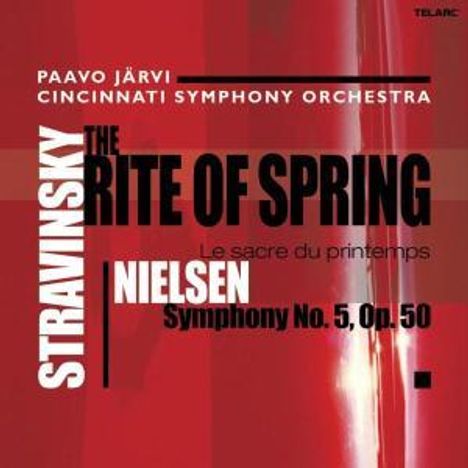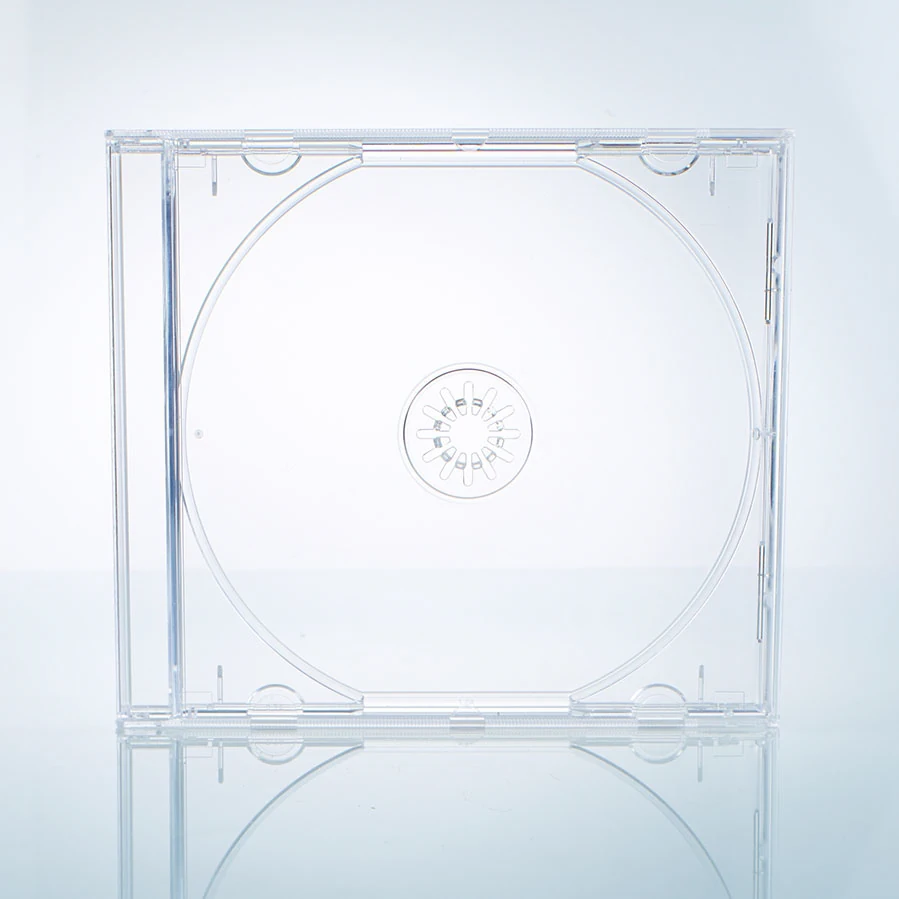Carl Nielsen: Symphonie Nr.5 auf CD
Symphonie Nr.5
Herkömmliche CD, die mit allen CD-Playern und Computerlaufwerken, aber auch mit den meisten SACD- oder Multiplayern abspielbar ist.
(soweit verfügbar beim Lieferanten)
+Strawinsky: Le Sacre Du Printemps
- Künstler:
- Cincinnati Symphony Orchestra, Paavo Järvi
- Label:
- Telarc
- Aufnahmejahr ca.:
- 2004
- Artikelnummer:
- 1349181
- UPC/EAN:
- 0089408061523
- Erscheinungstermin:
- 25.10.2004
Zwei höchst unterschiedliche Werke wie Carl Nielsens Fünfte Sinfonie und Igor Strawinskys „Le sacre du printemps“ hat sich der 1962 in Estland geborene Dirigent Paavo Järvi für seine aktuelle Telarc-Einspielung ausgesucht, die als CD und Hybrid-SACD erhältlich ist. Sowohl für das Cincinatti Symphony Orchestra als auch für den Hörer ist die Zusammenführung der Musik von zwei so unterschiedlichen Komponisten eine echte Herausforderung. Für den international hochgeehrten Järvi reicht es nicht aus die beiden Kompositionen nur einfach der Reihe nach zu präsentieren. Vielmehr reizt es ihn, eine interessante Symbiose zwischen den Stücken herzustellen. „Ihre Entstehung liegt zwar zeitlich sehr nahe beisammen, dennoch arbeiteten die beiden Komponisten ohne jegliche Beeinflussung vom Werk des anderen“, erklärt Järvi, der in dem aggressiven Charakter ihrer Musik durchaus Parallelen entdeckt. Ein amerikanisches Orchester und ein estnischer Dirigent, der nach Wahrhaftigkeit und Reinheit in der Musik strebt, stehen für die kongeniale Umsetzung der konstruktiven und zugleich destruktiven Kompositionen, in denen sich Dissonanzen und Harmonien abwechseln. Der Däne Carl Nielsen spiegelt in der Sinfonie No. 5 seine Sicht des Weltgeschehens nach dem 1. Weltkrieg, die zwischen Hoffnung und Verzweiflung schwankte. Dementsprechend stehen zwei in sich gegliederte Satzblöcke nebeneinander, die an harmonischer Härte und Rücksichtslosigkeit kaum zu übertreffen sind. Für den kosmopolitischen Strawinsky war Le sacre du printemps („The Rites of Spring“) ein ausgesprochen transzendentes Werk, das bei seiner Uraufführung 1913 in Paris einen der größten Eklats in der Musikgeschichte auslöste. Strawinskys neue Klänge schienen aus einer mysteriösen Welt zu stammen. Die musikalischen Imaginationen Strawinskys sind schon lange nicht mehr skandalträchtig. Paavo Järvi, der seit September 2001 das Cincinatti Symphony Orchestra leitet, sieht in den beiden Werken einen Anreiz das Orchester zu neuen Höchstleistungen zu animieren. Das Unterfangen kann als gelungen bezeichnet werden: zwei revolutionäre Werke, gespielt von einem der besten sinfonischen Orchester der Gegenwart.
Product Information
Paavo Järvi combines two very different works on his latest Telarc recording and creates a fascinating synergy that is a great example of this conductor’s innovative programming. By bringing together music of two different composers, he leaves the listener to discover the underlying similarities of the two compositions.
Nielsen’s Fifth Symphony, written in 1922, explores the confrontation of two moods, two personalities: the consonant and harmonic versus the dissonant and intense. These opposites have been characterized as the constructive and the destructive. Carl Nielsen’s music spans the boundary between Romanticism and Modernism.
His Fifth Symphony is a direct response to WWI’s effects on the Danish community and an attempt to show the inherent conflict between man’s better instincts and the inclination towards evil. Written in two movements, Nielsen’s Fifth is deceptive as it is divided into four distinct sections. The opening of the first movement is dark and quiet, and second movement builds on the darkness and eventually explodes into the light – an expression of Nielsen’s more optimistic side.
Unlike Nielsen, Stravinsky was a cosmopolitan Russian about to turn Frenchman and eventually American. The Rite of Spring is a transcending work, one that is reflective of a specific time. Like many revolutionary works, the Rite takes its inspiration from extra-musical sources. During the spring of 1910, Stravinsky had a vision: “I saw in my imagination a solemn pagan rite: wise elders, seated in a circle, watching a young girl dance herself to death. They were sacrificing her to propitiate the god of spring.” The Rite is full of simple, folk-like melodies, often with not more than four or five different notes. These tunes are usually accompanied by biting dissonances or shimmering textures.
“To put together these two composers, not usually associated with one another, is to create an interesting symbiosis,” says Järvi in the liner notes. “They are nearly contemporaries, yet they each worked without influence from the other. Their visions of aggression in music were not dissimilar, but their means were different.”
Paavo Järvi is one of the most celebrated conductors on the current classical scene. Telarc’s previous recordings with the Cincinnati Symphony Orchestra under the leadership of Paavo Järvi have garnered high acclaim. Gramophone called their 2003 Stravinsky recording “outstanding in every way,” with a Petrouchka performance that is “arresting.” American Record described the CSO’s recording of Prokofiev’s Romeo & Juliet suites as a work of “boundless enthusiasm and youthful exuberance.”
(concordmusicgroup. com)
Rezensionen
"Die Telarc-Tonmeister haben wieder ein sehr luftiges und transparentes Klangbild geschaffen, das die exquisiten Sololeistungen ebenso herausstellt wie die perfekte Balance der Register."Disk 1 von 1 (CD)
-
1 Introduction
-
2 The Harbingers Of Spring / Dances Of The Young Girls
-
3 Game Of Abduction
-
4 Spring Rounds
-
5 Games Of Rival Tribes
-
6 Procession Of The Sage
-
7 The Sage
-
8 Dance Of The Earth
-
9 Introduction
-
10 Mystic Circles Of The Young Girls
-
11 Glorification Of The Chosen One
-
12 Evocation Of The Elders
-
13 Ritual Action Of The Elders
-
14 Sacrificial Dance
-
15 Tempo Giusto
-
16 Adagio Non Troppo
-
17 Allegro
-
18 Presto
-
19 Andante Un Poco Tranquillo
-
20 Allegro
Mehr von Carl Nielsen
-
Carl NielsenSymphonien Nr.1-63 CDsVorheriger Preis EUR 29,99, reduziert um 0%Aktueller Preis: EUR 12,99
-
Hans AbrahamsenStreichquartett "10 Preludes"CDVorheriger Preis EUR 16,99, reduziert um 0%Aktueller Preis: EUR 6,99
-
Carl NielsenViolinkonzert op.33CDAktueller Preis: EUR 15,99
-
Carl NielsenAladdinCDAktueller Preis: EUR 12,99







